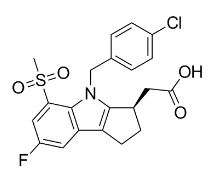
Laropiprant (1 µM) causes a significant inhibition of the aggregation but still counteractes the pronounced inhibition caused by PGD2 (30 nM) and BW245c (3 nM). Laropiprant blocks DP receptor-dependent increase in VASP phosphorylation, as well as inhibition of P-selectin expression, GPIIb/IIIa activation and in vitro thrombus formation. Laropiprant antagonizes the increased platelet aggregation by TP and EP3 receptor activation. Laropiprant (10 µM) and niacin inhibit in vitro thrombus formation.
| Cell Experiment | |
|---|---|
| Cell lines | |
| Preparation method | |
| Concentrations | |
| Incubation time | |
| Animal Experiment | |
|---|---|
| Animal models | |
| Formulation | |
| Dosages | |
| Administration | |
| Molecular Weight | 435.9 |
| Formula | C21H19ClFNO4S |
| CAS Number | 571170-77-9 |
| Solubility (25°C) | 10 mM in DMSO |
| Storage |
Powder -20°C 3 years ; 4°C 2 years In solvent -80°C 6 months ; -20°C 1 month |
| Species | Mouse | Rat | Rabbit | Guinea pig | Hamster | Dog |
| Weight (kg) | 0.02 | 0.15 | 1.8 | 0.4 | 0.08 | 10 |
| Body Surface Area (m2) | 0.007 | 0.025 | 0.15 | 0.05 | 0.02 | 0.5 |
| Km factor | 3 | 6 | 12 | 8 | 5 | 20 |
| Animal A (mg/kg) = Animal B (mg/kg) multiplied by | Animal B Km |
| Animal A Km |
For example, to modify the dose of Compound A used for a mouse (20 mg/kg) to a dose based on the BSA for a rat, multiply 20 mg/kg by the Km factor for a mouse and then divide by the Km factor for a rat. This calculation results in a rat equivalent dose for Compound A of 10 mg/kg.
| Related Dopamine Receptor Products |
|---|
| SV 156
SV 156 is a potent and selective D2 dopamine receptor antagonist, with a Ki of 2.5 nM for hD2. SV 156 has approximately 40-fold binding selectivity for D2 dopamine receptors compared to the D3 receptor subtype. |
| Cyclo(glycyl-L-leucyl)
Cyclo(glycyl-L-leucyl) (Cyclo(leu-gly)), a neuropeptide, down-regulates dopamine (DA) receptors and attenuates dopaminergic supersensitivity. |
| Onzigolide
Onzigolide (BIM-23A760), a chimeric dopamine-somatostatin compound, shows potent agonist activity at both DA type 2 (D2R) and SST type 2 (SSTR2) receptors. |
| CVL-871
CVL-871 is a partial agonist at dopamine D1/5 receptors and may be used in dementia-related studies. |
| Paliperidone palmitate
Paliperidone palmitate is the ester precursor compound of Paliperidone, a potent dopamine antagonist and 5-HT2A antagonist. Paliperidone is a potent dopamine antagonist and 5-HT2A antagonist. |


Products are for research use only. Not for human use. We do not sell to patients.
© Copyright 2010-2023 AbMole BioScience. All Rights Reserved.
